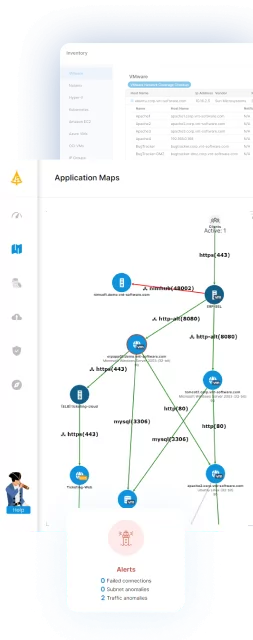What Are Configuration Management Tools?
Configuration management tools automate the process of managing, tracking, and controlling changes to IT infrastructure and software configurations. They are essential for maintaining system consistency, enabling efficient and controlled changes, and supporting DevOps practices like Infrastructure as Code (IaC), Continuous Integration/Continuous Delivery (CI/CD), and compliance management.
Table of Contents
ToggleThese tools allow organizations to manage complex environments more efficiently by defining system settings, software installations, security policies, and updates as code, which ensures that every asset stays in its designated state. They help minimize human error, promote consistency, and accelerate the deployment of new services or features.
Key capabilities of configuration management tools include:
-
- Identification: Identifying all elements of a system’s state.
-
- Control: Coordinating and limiting access to configurations.
-
- Auditing: Confirming that changes conform to a system’s desired state.
- Status accounting: Automatically recording code changes and details.
Primary Functions of Configuration Management Tools
Automation of Infrastructure Provisioning
Configuration management tools automate the setup and deployment of servers, applications, and network devices. Through predefined configuration files or scripts, these tools can bring up an entire environment in minutes, which reduces the time spent on manual provisioning. This approach supports reproducibility, letting teams replicate identical environments for development, testing, and production with minimal effort.
Automation minimizes configuration drift and ensures that all deployed assets conform to organizational standards. It improves scalability, allowing administrators to handle hundreds or thousands of systems without a proportional increase in workload. As a result, IT operations become more predictable, dependable, and easier to manage during growth or transitions.
Declarative Configuration Management
Declarative configuration management enables teams to define the desired state of infrastructure rather than specifying step-by-step instructions. Tools interpret these declarations and automatically adjust resources until they match the described outcome. This model ensures that if a system deviates from its intended state, the management tool will correct it during the next enforcement cycle.
This approach supports greater resiliency and reduces troubleshooting complexity. Because configuration is expressed as code, teams can easily review, audit, and modify system states without intricate procedural logic. Declarative methods are especially effective for large or distributed systems where manual oversight would be impractical and error-prone.
Version Control and Change Management
Configuration management tools often integrate directly with version control systems like Git. Every change to infrastructure configuration is tracked, allowing administrators to view historical changes, compare versions, and roll back to previous states as needed. This granular visibility is critical for both collaborative change management and audit compliance.
Version-controlled configurations make it easier to understand the evolution of infrastructure and enable seamless rollbacks in case of problems. When issues arise, teams can quickly isolate which changes introduced them and revert accordingly. This process improves the stability, transparency, and recoverability of IT environments.
Consistency Across Environments
Ensuring consistency across development, testing, and production environments is a core function of configuration management tools. By applying the same configuration files or code to every stage, organizations eliminate discrepancies that can cause unexpected behavior or failures during deployment.
This reduces bugs, improves reliability, and speeds up delivery cycles. Consistent environments promote confidence when moving applications from one stage to another. Teams no longer need to rely on ad-hoc scripts or manual updates, which are prone to drift and misconfiguration. These tools help maintain standardization, reducing support issues and simplifying documentation and knowledge transfer across teams.
Compliance and Security Enforcement
Configuration management tools can enforce compliance and security requirements by embedding rules and policies directly in configuration code. This allows organizations to standardize security settings, user permissions, and software versions, reducing the risk of vulnerabilities and ensuring regulatory compliance. Any deviation from these standards can be automatically corrected or flagged for review.
Automated compliance monitoring simplifies audit preparation and regulatory reporting. It provides a continuous mechanism to detect and remediate non-conforming changes, ensuring that required controls are always active. This approach lowers the risk of data breaches and allows organizations to demonstrate robust governance to stakeholders.
Monitoring and Reporting
Integrated monitoring and reporting functions allow configuration management tools to provide visibility into system states. They can detect unauthorized changes, failed deployments, or compliance issues, alerting teams promptly to intervene before problems escalate. Historical reports help identify trends, recurring issues, or opportunities for further automation.
Comprehensive reporting enables proactive management and ongoing improvement of infrastructure processes. By correlating configuration changes with system performance or incidents, organizations can refine their practices and policies, improving efficiency and resilience over time.
Integration with CI/CD Pipelines
Configuration management tools often integrate deeply with continuous integration and continuous deployment (CI/CD) pipelines. This integration ensures that configuration changes are tested, validated, and automatically applied alongside application deployments. It aligns infrastructure updates with the cadence of software delivery, reducing manual steps and the risk of misaligned environments.
Tight CI/CD integration supports rapid iteration and frequent deployment cycles common in modern DevOps practices. It enforces automated checks and rollbacks, ensuring that infrastructure changes are safe and reversible. This allows teams to deliver value faster while maintaining reliability and control over both code and underlying resources.

Lanir specializes in founding new tech companies for Enterprise Software: Assemble and nurture a great team, Early stage funding to growth late stage, One design partner to hundreds of enterprise customers, MVP to Enterprise grade product, Low level kernel engineering to AI/ML and BigData, One advisory board to a long list of shareholders and board members of the worlds largest VCs
Tips from the Expert
In my experience, here are tips that can help you better leverage configuration management tools in complex IT environments:
- Start with a baseline “desired state” blueprint: Before automating, document and codify a golden configuration for each environment (dev, test, prod). This baseline simplifies drift detection and speeds up disaster recovery efforts.
- Separate configuration data from logic: Use parameterized templates and externalize environment-specific variables (e.g., in vaults or parameter stores) to avoid duplicating configuration code and reduce risk when promoting changes across environments.
- Build immutable infrastructure wherever possible: Instead of updating live servers, recreate systems from versioned configurations. This approach eliminates configuration drift and allows faster, more reliable rollbacks.
- Leverage canary and blue-green deployments for config changes: Don’t push configuration updates to all systems at once. Roll out changes gradually and monitor impact before full deployment to avoid system-wide failures.
- Harden configurations against security threats by default: Integrate CIS Benchmarks, STIGs, or custom security baselines directly into configuration code to enforce secure states and block insecure defaults.
Notable Configuration Management Tools
1. Ansible
Ansible is an open-source automation tool that enables infrastructure as code, intended for software provisioning, configuration management, and application deployment. It is agentless, meaning it doesn’t require installation on managed nodes, instead using SSH or Windows Remote Management for temporary connections.
Key features include:
- Declarative configuration: Uses simple YAML syntax for defining system states.
- Idempotent operations: Ensures consistent configurations, even if tasks are repeated.
- Multi-platform support: Compatible with Unix-like systems, including macOS, and Windows via WSL.
- Playbooks: Allows the automation of tasks in a straightforward, human-readable format.
- Inventory management: Supports dynamic inventory through scripts, pulling data from various sources.
Source: Ansible
2. Puppet
Puppet is a configuration management tool that automates the management and deployment of infrastructure across a range of systems, including Unix-like systems and Microsoft Windows. Developed by Puppet Inc., the tool is designed to manage the IT infrastructure lifecycle through declarative configuration.
Key features include:
- Client-server architecture: Uses a master-agent model, with Puppet Server acting as the master and Puppet Agent installed on managed nodes.
- Declarative configuration language: Puppet’s custom language allows users to define system configurations without needing deep programming knowledge.
- Cross-platform support: Compatible with various operating systems, including Linux, Solaris, BSD, macOS, AIX, HP-UX, and Windows.
- Resource management: Allows defining and managing resources such as users, services, and files using simple declarative syntax.
- Scalability: Designed to handle large-scale infrastructure, with centralized control over configurations and reporting.
Source: Puppet
3. Progress Chef
Chef is a configuration management tool that automates the management of infrastructure and ensures it remains consistent and compliant over time. Designed for large-scale and complex environments, it enables organizations to define configurations and policies as code, which can be tested, enforced, and delivered at scale.
Key features include:
- Policy-based configuration management: Defines configurations and policies as code, enabling testable, enforceable, and repeatable automation.
- Drift elimination: Automatically detects and corrects configuration drift, ensuring that systems comply with desired states.
- Cross-platform management: Supports management of a range of systems, including Linux, Windows, ARM systems, and edge devices.
- Flexibility: Provides declarative definitions for common tasks, while offering extensibility to meet unique environmental requirements.
- Integrated automation workflow: Includes Chef Workstation for creating, testing, and managing policies, Chef Infra Client for system state enforcement, and Chef Automate for data aggregation and state validation.
Source: Chef
4. Terraform
Terraform is an infrastructure-as-code (IaC) tool developed by HashiCorp that allows users to define and provision data center infrastructure using declarative configuration. Written in HashiCorp Configuration Language (HCL) or JSON, it enables automation of the provisioning and management of cloud infrastructure, network appliances, and software services across various platforms.
Key features include:
- Declarative configuration: Users define the desired state of infrastructure, and Terraform automatically handles the creation, modification, and deletion of resources to reach that state.
- Provider support: Integrates with various providers, including AWS, Microsoft Azure, Google Cloud, VMware vSphere, and Oracle Cloud.
- Infrastructure as code: Defines and provisions infrastructure using human-readable configuration files, which can be version-controlled and maintained in code repositories.
- Reusability through modules: Allows users to create reusable modules that encapsulate common infrastructure patterns.
- State management: Maintains an up-to-date state of infrastructure, which enables accurate tracking and management of changes over time.
Source: HashiCorp
5. SaltStack
SaltStack, commonly referred to as Salt, is an event-driven automation tool built in Python for deploying, configuring, and managing IT systems. It is designed to handle configuration management, remote execution, and orchestration of systems, ensuring that infrastructure components remain in a desired and consistent state.
Key features include:
- Configuration management: Automates the management of systems, ensuring packages are installed, services are running, and configurations remain consistent.
- Event-driven automation: Responds to system events, enabling automatic remediation or orchestration based on triggers.
- Remote execution: Allows commands to be executed across multiple systems in parallel, using secure, encrypted communications.
- Scalability and speed: Built to handle large-scale environments, can manage thousands of systems quickly.
- Pluggable and customizable: Integrates with existing technologies and can be customized to suit unique environments or workflows.
6. CFEngine
CFEngine is an enterprise automation tool that ensures infrastructure remains secure, compliant, and consistently configured across a range of environments, from private and public cloud servers to desktops and IoT devices. It helps organizations enforce compliance, minimize vulnerabilities due to configuration drift, and rapidly deploy updates.
Key features include:
- Automation: Automates configuration management across a variety of platforms, including servers, cloud instances, desktops, and IoT devices.
- Security and vulnerability management: Minimizes configuration drift, allowing for quick updates and changes to be deployed.
- Compliance enforcement: Continuously enforces compliance with internal and external regulations.
- Mission portal: Provides a centralized dashboard offering visibility into configuration issues, compliance status, and infrastructure inventory, with customizable and shareable reports.
- Monitoring: Tracks compliance levels, system performance, and infrastructure health.
Source: CFEngine
7. Auvik
Auvik is a cloud-based network configuration management tool to simplify network operations by providing visibility into changes, ensuring compliance, and simplifying device management. It automatically tracks and compares device configurations, providing insights into changes made to the network.
Key features include:
- Automated configuration management: Compares network device configurations, highlighting changes, additions, and removals.
- End-user device management: Centralizes the management of end-user devices, making it easier to push policies and updates across the network.
- Auditing and compliance: Automatically tracks and time-stamps network changes, providing an audit trail to ensure compliance.
- Automated backups: Keeps frequent backups of configurations to protect against accidental changes and ensure quick recovery if needed.
- Change visibility: Provides visibility into changes made to configurations, allowing for immediate identification and resolution of potential issues.
Source: Auvik
Supporting Configuration Management with Faddom Dependency Mapping
Configuration management tools are essential for maintaining consistency and automating infrastructure changes. However, they often lack the comprehensive visibility that IT teams need to understand how these changes affect business applications and their dependencies. Faddom addresses this gap by providing real-time mapping of every server, application, and traffic flow. This ensures that any changes made through configuration management tools are fully understood, documented, and assessed for risk before implementation.
By integrating automated configuration with Faddom’s agentless application dependency mapping, organizations can minimize downtime, enhance compliance, and maintain continuous clarity across hybrid and cloud environments. Faddom also utilizes AI-powered anomaly detection to identify unusual traffic patterns that may indicate misconfigurations or security threats, enabling IT teams to shift from a “set it and forget it” approach to proactive management.
Book a demo today to see how Faddom can complement your configuration management tools with complete real-time visibility!






